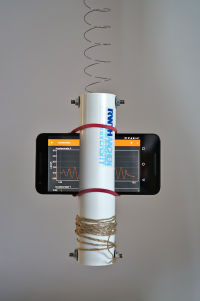Experiment: Pendulum
| Experiment | Pendulum |
|---|---|
| Category | Mechanics |
| Used sensors | Gyroscope |
The experiment "Pendulum" tracks the movement of a string pendulum and determines its period and frequency. Additionally, if you provide the length of the string, it can calculate "g", the local gravitational acceleration.
(This experiment is quite similar to the Experiment: Spring, which is used for a pendulum attached to a spring.)
Requirements
You need a string and a mount for your phone, so you can attach it to the string. A simple mount can be made from a small paper roll like the inner part of a toilet paper roll, a rubber band and a screw.
Also, a second device as a remote control for the experiment is advisable.
Setup
Mount
The mount in the picture to the right is made from a plastic tube, but the principle can be applied to a paper tube (for example from toilet paper) as well. Cut out an oblong hole on each side of the tube, so you can stick your phone through it. Put a screw into the top of the tube, so you can attach the string here. Finally secure your phone with a rubber band.
The picture actually shows the setup for the spring experiment. The string used for the pendulum experiment is visible in the bottom part of the picture. The second screw at the bottom has the same function as the one at the top.
Experiment
Open the "pendulum" experiment in phyphox and setup the remote access to your second device (alternatively, you may work with timed experiments, but the buttons on your phone may be hard to reach in the mount). Enter the length of your string either on the phone or on the remote interface. You want to measure the length from one end of the string (attached to a stand or something similar) to the center of mass of your phone. Usually the geometric center of your phone is a good starting point, but if you want to be sure you should search the point on which you can balance your phone.
Place the phone in the mount and make sure that it is secured with the rubber band (really, make sure it is properly attached - you don't want to drop your phone!). Attach the mount to the string and let it swing. If you are interested in determining "g", let it only swing slightly as the calculations are inaccurate for large angles. Finally, while swinging, start the experiment to determine the oscillation frequency and period.
Analysis
phyphox will record the angular velocity of your phone during the experiment. It should follow a sine function with the extreme values (maximum absolute angular velocity) at the lowest point of the swing movement.
To determine the period of this oscillation, phyphox calculates the autocorrelation of the data. The first maximum (after the maximum at zero) is taken as the period and its inverse as the oscillation frequency.
The local gravitational acceleration is calculated from the simple period equation using the small angle approximation and a massless cord.
Problems and resolutions
- High-frequency oscillations on top of the actual swing oscillation. This may happen if the phone "wobbles" about other axes. The sensor picks up all rotations, so try to start the oscillation without rotating the phone.
- The gravitational acceleration "g" is off. If the frequency has been determined correctly, there are two possible sources for errors in "g". On one hand, you may use a too wide swing. The calculations use a small angle approximation and are only valid if you stick to small pendulum movements. On the other hand, the length of the string entered in the app may be wrong. This should not just be the length of the wire, but the distance from the point where the string is attached to a stand to the center of mass of the phone. If you are unsure about the center of mass, you can try to balance your phone on the tip of a finger (be careful not to drop and damage your phone!) - When you succeed, the phone is resting on its center of mass.
